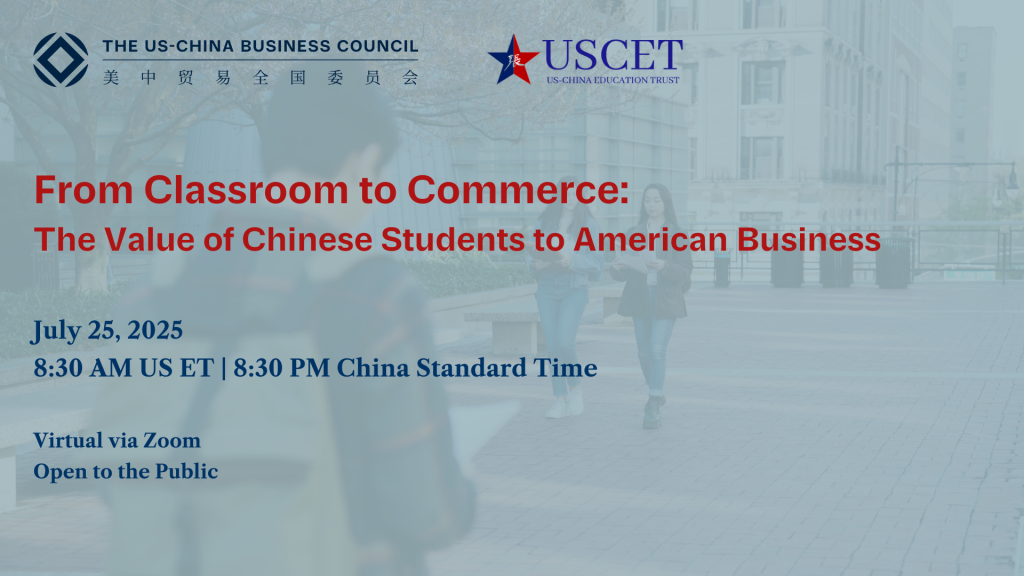
USCET, in partnership with the U.S.-China Business Council (USCBC), hosted a webinar focused on the role of international education in U.S.-China relations. Held on July 25, 2025, the program highlighted education as not only a pillar of bilateral exchange but also a strategic asset underpinning American innovation, global competitiveness, and soft power.
Sean Stein, President of USCBC, set the stage with a powerful reminder: “Education is the United States’ top service export.” In 2023 alone, spending by Chinese students and their families in the U.S. reached $14.4 billion, supporting over 143,000 jobs – more than exports in oil, gas, semiconductors, or aerospace. Stein warned that as visa restrictions and national security concerns grow, so too does the risk of losing access to global talent.
“The stakes are innovation and competitiveness, and the stakes are global leadership”
Ambassador Julia Chang Bloch, Executive Chair of USCET, reinforced this message in her opening remarks. She framed the conversation as a timely opportunity to reflect on what’s truly at stake when openness to international students is called into question. Chinese students, she emphasized, are far more than tuition contributors—they are innovators, entrepreneurs, and future partners in research, business, and diplomacy. These human connections, she noted, are not peripheral, but foundational to stabilizing the broader U.S.-China relationship.
Following the remarks, Omar Chihane, TOEFL® general manager at ETS opened the panel by reflecting on six decades of supporting Chinese learners through the TOEFL program. While the U.S. remains the top destination for Chinese test takers, he noted a growing trend of students applying to multiple countries—not only in the West, but increasingly across Asia, Europe, and the Middle East. Prestige alone is no longer enough; students are now weighing how welcomed they feel, the clarity of admissions and post-graduation pathways, and the value of their degrees in the job market. Chihane emphasized that restoring international students’ trust in the U.S. should start with a clear message: “You are welcome here.”
Amy Gadsden, executive director of Penn China Initiatives and associate vice provost for global initiatives at the University of Pennsylvania, followed, offering a perspective from university leadership. She stressed that the strength of American higher education depends on its ability to attract global talent—not only students, but also faculty, many of whom are foreign-born and now naturalized citizens. Yet visa uncertainty and political pressure are undermining that strength. Gadsden warned against reducing Chinese students to national security risks, pointing out they study across all disciplines, not just sensitive fields. Framing them in narrow terms reinforces damaging stereotypes. Drawing a sharp parallel to the current climate in academia, she urged the audience to consider how troubling it would be if U.S. companies faced similar restrictions on where they could do business.
Yanzhong Huang, director of the Center for Global Health Studies at Seton Hall University and senior fellow at the Council on Foreign Relations, followed with a personal reflection, calling himself both a “specimen” and beneficiary of U.S.-China educational exchange. His time at the Johns Hopkins Nanjing Center sharpened his critical thinking and helped launch his policy career. But today, he noted, many Chinese students are hesitant to come to the U.S., concerned about being treated with suspicion. This over-securitization, he warned, plays directly into Chinese state narratives, fueling a vicious cycle that harms both countries. Most Chinese students come to learn, not to threaten, and treating them as potential risks undermines one of the most successful forms of bilateral engagement.
“Only when I came to this country, I learned the importance of exposure to multiple perspectives and to adopt a critical thinking approach to my studies”
The panel then turned to the broader question of innovation and national security. If Chinese students are turned away, Stein asked, what happens to the U.S. research ecosystem? Gadsden pointed to the example of Nobel laureate Katalin Karikó, a visiting scholar who later developed the mRNA technology behind COVID vaccines: an innovation made possible by a strong international talent pipeline. She added that foreign-born faculty and students routinely collaborate, learn from one another, and drive discovery. Losing them would be a strategic loss for the United States.
While panelists acknowledged that national security is a legitimate concern, they urged for a more calibrated approach. Huang advocated for targeted policies that focus on high-risk fields like AI or quantum computing, while expanding cooperation in non-sensitive areas like public health or the social sciences. Gadsden added that most espionage cases in the U.S. stem from corporate actors, not international students, and that the true issue is not security but a growing knowledge gap in critical sectors. If anything, she argued, the U.S. should retain international students to help close it.
“Some of the risks are much better attacked with a scalpel than a sledgehammer”
Sean Stein concluded the panel by re-emphasizing that the diversity of international students and global talent gives the United States a distinct edge in critical sectors. At the same time, he noted that the country must confront its growing knowledge and skills gap. Citing a recent U.S. Embassy tweet that read, “every visa adjudication is a national security decision,” he acknowledged the importance of security but questioned whether such messages reflect the welcome that students seek. Students are paying close attention to how they’re treated—and if the U.S. falters, others will step in. As the panel emphasized, sustaining openness and global engagement is not only in America’s interest, it remains one of its greatest strengths.
